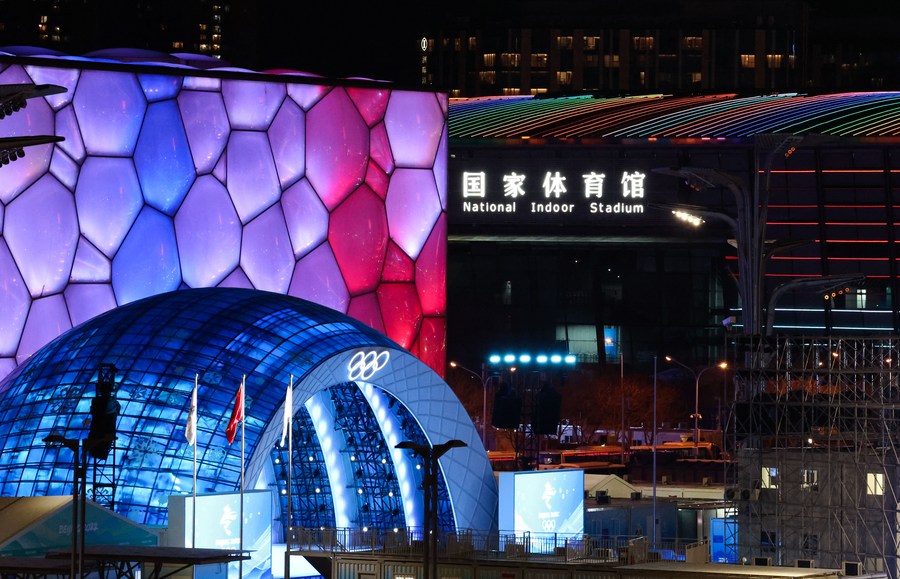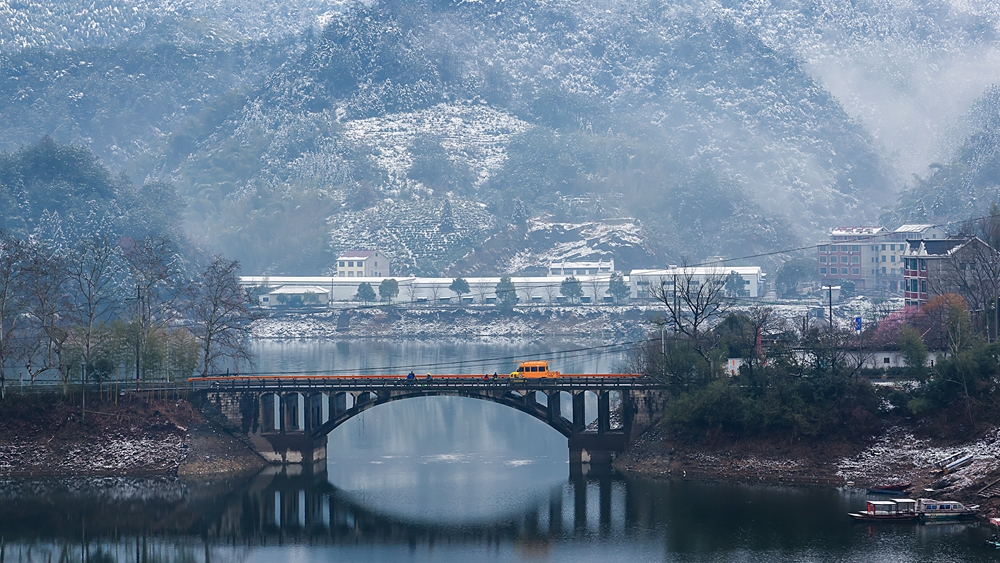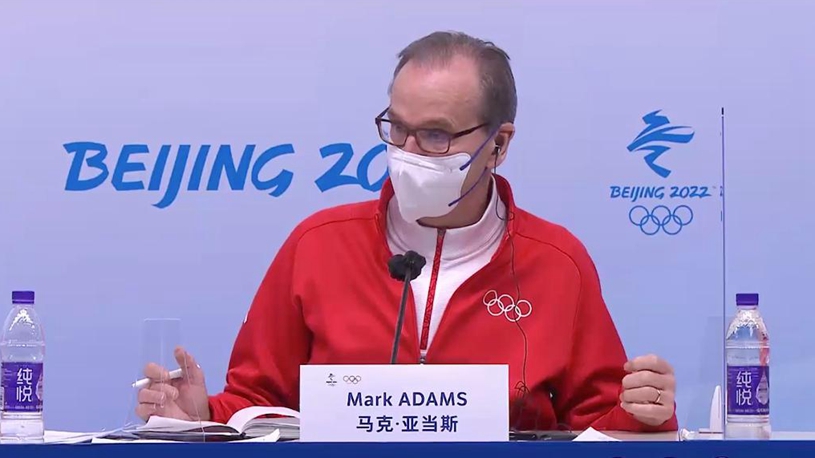
Aerial photo taken on Aug. 19, 2020 shows wind turbines in Jiucaiping scenic spot in southwest China's Guizhou Province. (Xinhua/Liu Xu)
BEIJING, Feb. 25 (Xinhua) -- The Beijing Winter Olympics which closed Sunday became the first Games in history to be carbon neutral; this is an unlikely achievement that could not have happened without China's greening transformation over the past decade.
Previous Winter Olympics have claimed to be carbon neutral, but China is considering a much broader range of emissions, an article on Nature's website quoted the International Olympics Committee as saying. It notes that China has been investing heavily in renewable energy as part of its overall goal of achieving carbon neutrality by 2060.
Amid a great deal of green efforts is the eye-catching renovation of used Olympic venues. The 'Ice Cube,' a premier curling venue, for instance, was retrofitted from the iconic 'Water Cube', swimming and diving venue of Beijing 2008, and at the Shougang competition zone, world-class facilities were repurposed from a disused steel plant.
These new landmarks not only offered audiences captivating sights but also attested to the sweeping changes in China's economic landscape toward greater sustainability under the guidance of Chinese President Xi Jinping's economic thought.

Photo taken on Feb. 4, 2022 shows the National Aquatics Center (also known as the "Ice Cube"), the National Indoor Stadium and the Beijing Medals Plaza of the Winter Olympics after the opening ceremony of the Beijing 2022 Olympic Winter Games at the National Stadium in Beijing, capital of China. (Xinhua/Wang Jingqiang)
AN OVERALL TRANSFORMATION
Back in 2012, the country began to face dual pressure from both the slowing growth in the aftermath of the international financial crisis and environmental woes caused by years of extensive development.
That year, China's aggregate gross domestic product (GDP) accounted for 11.5 percent of the world's total, but its energy consumption per unit of GDP, or energy intensity, was 2.5 times that of the world's average level.
"We owe so much to the ecological environment. If we don't do solid green work from now on, we will pay a higher price in the future," Xi said in December 2012, during his first inspection trip out of Beijing as general secretary of the Communist Party of China Central Committee.
Since then, China has ramped up its efforts on an unprecedented scale to advance the greening transition of the economy as Xi's hallmark green development phrase "lucid waters and lush mountains are invaluable assets" become a maxim in the country.
Taking energy mix, for instance, the world's second-largest economy began to be less reliant on coal and other fossil energies causing high emissions, while increasing the proportion of clean energies.
In 2021, energy intensity dropped by 2.7 percent from the previous year, official data has shown. The progress came as the indicator declined by 28.7 percent from 2011 to 2020.
The proportion of coal in China's total energy consumption was reduced from 69.2 percent to 56.7 percent during the 2010-2020 period.
In 2021, the share of coal consumption further dropped by 0.8 percentage points year on year, while that of clean energies including natural gas, hydropower, nuclear power, wind power, and solar energy climbed 1 percentage point.
"Protecting the environment is protecting productivity, and improving the environment is boosting productivity," Xi said during an inspection trip to south China's Hainan Province in April 2013.
Along with the transformation of energy structure, China has also steadfastly prompted its upgrade of industrial structure, with the service sector and low-carbon industries growing rapidly.
Accounting for 53.3 percent of China's total GDP last year, the service sector's contribution rate to economic growth reached 54.9 percent, 16.5 percentage points higher than the second industry.
For the primary industry itself, carbon emissions have continued to decline. It is estimated that from 2015 to 2020 carbon dioxide emissions per unit of added value of Chinese industries fell by about 22 percent, according to a white paper on China's response to climate change.

Aerial photo taken on Oct. 31, 2021 shows swans at the Hekou Reservoir wetland in Yulin, northwest China's Shaanxi Province. To the south of the Maowusu Desert, the Yuyang District has witnessed improvement in eco-environment thanks to decades of afforestation efforts. (Xinhua/Tao Ming)
CAMPAIGN FOR BETTER ENVIRONMENT
The last 10 years have also witnessed China's unprecedented moves on improving the environment, from controlling air, water and soil pollution to conserving existing green ecosystems as well as adding new forests, grasslands and wetlands.
"We should protect the environment like we protect our eyes, and treat the environment like we treat our lives," Xi said when joining a deliberation with lawmakers from east China's Jiangxi Province at the annual meeting of the National People's Congress in 2015.
Last year, the share of days with good air quality rose to 87.5 percent, up 0.5 percentage points from 2020. The progress was built on marked improvements during the 13th Five-Year Plan period (2016-2020), which increased by 5.8 percentage points to 87 percent.
Good air days came along with the fast growth of green areas. Earlier data from NASA satellites showed that China alone accounts for 25 percent of the global net increase in leaf area during 2000-2017.
Joining Beijing citizens to plant trees in April last year, Xi urged greater efforts to increase the country's forest areas, enhance the quality of forests and boost the carbon sink capacity of ecosystems. Since 2013, Xi has joined Beijing citizens in tree-planting activities for nine consecutive years.
Data from the white paper on responding to climate change showed that from 2016 to 2020, China had planted around 36.3 million hectares of forests and added 202,600 hectares of new wetlands.
Aiming for a greener and more sustainable future, China has revved up its policy support to achieve the goals of carbon peaking before 2030 and carbon neutrality before 2060, which Xi put forward in 2020 at the General Debate of the 75th Session of the UN General Assembly.
Within less than two years, a set of policy arrangements have been unveiled in this respect, involving both top-level designs and institutional innovations.
In late October last year, central authorities issued a guiding document on achieving the carbon goals, laying out key specific targets and measures for the coming decades. By 2030, China's carbon emissions will peak, stabilize and then decline, and by 2060, China will be carbon neutral and have fully established a green, low-carbon and circular economy, it says.
Going forward, challenges will remain. But in Xi's opinion, there is no turning back.
"Meeting these [carbon peaking and neutrality] targets will require tremendous hard work from China. Yet we believe that when the interests of the entire humanity are at stake, China must step forward, take action, and get the job done", Xi said when addressing the World Economic Forum Virtual Event of the Davos Agenda in 2021. ■












